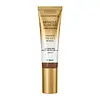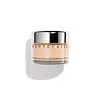What's inside
What's inside
 Key Ingredients
Key Ingredients

 Benefits
Benefits

 Concerns
Concerns

 Ingredients Side-by-side
Ingredients Side-by-side

Water
Skin ConditioningCyclopentasiloxane
EmollientPhenyl Trimethicone
Skin ConditioningGlycerin
HumectantMica
Cosmetic ColorantCetyl PEG/PPG-10/1 Dimethicone
EmulsifyingDiisopropyl Dimer Dilinoleate
EmollientCocos Nucifera Oil
MaskingTrimethylsiloxysilicate
EmollientZinc Oxide
Cosmetic ColorantSodium Chloride
MaskingPEG-10 Dimethicone
Skin ConditioningAmmonium Acrylates Copolymer
Phenoxyethanol
PreservativeDisteardimonium Hectorite
StabilisingAlpha-Glucan Oligosaccharide
CleansingLecithin
EmollientPentylene Glycol
Skin ConditioningChlorphenesin
AntimicrobialPropylene Carbonate
SolventParfum
MaskingTocopheryl Acetate
AntioxidantIsopropyl Titanium Triisostearate
EmollientAlcohol Denat.
AntimicrobialPolymnia Sonchifolia Root Juice
Skin ConditioningAloe Barbadensis Leaf Juice
Skin ConditioningAscorbyl Glucoside
AntioxidantCitric Acid
BufferingFructose
HumectantSodium Hydroxide
BufferingUrea
BufferingDisodium Deceth-6 Sulfosuccinate
CleansingMaltodextrin
AbsorbentRetinyl Palmitate
Skin ConditioningTriethoxycaprylylsilane
Cocos Nucifera Fruit Extract
EmollientLaureth-30
CleansingPEG-60 Hydrogenated Castor Oil
EmulsifyingHexyl Cinnamal
PerfumingAllantoin
Skin ConditioningMaltose
MaskingSodium Lactate
BufferingSodium PCA
HumectantTrehalose
HumectantBenzyl Benzoate
AntimicrobialCitronellol
PerfumingLinalool
PerfumingSodium Dehydroacetate
PreservativeLactobacillus
Skin ConditioningPanthenol
Skin ConditioningTocopherol
AntioxidantCaprylyl Glycol
EmollientGlucose
HumectantSodium Hyaluronate
HumectantPhenethyl Alcohol
MaskingEugenol
PerfumingPotassium Sorbate
PreservativeSodium Benzoate
MaskingGeraniol
PerfumingSilybum Marianum Seed Extract
Skin ConditioningHelianthus Annuus Seed Oil
EmollientRosmarinus Officinalis Leaf Extract
AntimicrobialPentaerythrityl Tetra-Di-T-Butyl Hydroxyhydrocinnamate
AntioxidantPantolactone
HumectantBHT
AntioxidantLimonene
PerfumingIron Oxides
CI 77891
Cosmetic ColorantWater, Cyclopentasiloxane, Phenyl Trimethicone, Glycerin, Mica, Cetyl PEG/PPG-10/1 Dimethicone, Diisopropyl Dimer Dilinoleate, Cocos Nucifera Oil, Trimethylsiloxysilicate, Zinc Oxide, Sodium Chloride, PEG-10 Dimethicone, Ammonium Acrylates Copolymer, Phenoxyethanol, Disteardimonium Hectorite, Alpha-Glucan Oligosaccharide, Lecithin, Pentylene Glycol, Chlorphenesin, Propylene Carbonate, Parfum, Tocopheryl Acetate, Isopropyl Titanium Triisostearate, Alcohol Denat., Polymnia Sonchifolia Root Juice, Aloe Barbadensis Leaf Juice, Ascorbyl Glucoside, Citric Acid, Fructose, Sodium Hydroxide, Urea, Disodium Deceth-6 Sulfosuccinate, Maltodextrin, Retinyl Palmitate, Triethoxycaprylylsilane, Cocos Nucifera Fruit Extract, Laureth-30, PEG-60 Hydrogenated Castor Oil, Hexyl Cinnamal, Allantoin, Maltose, Sodium Lactate, Sodium PCA, Trehalose, Benzyl Benzoate, Citronellol, Linalool, Sodium Dehydroacetate, Lactobacillus, Panthenol, Tocopherol, Caprylyl Glycol, Glucose, Sodium Hyaluronate, Phenethyl Alcohol, Eugenol, Potassium Sorbate, Sodium Benzoate, Geraniol, Silybum Marianum Seed Extract, Helianthus Annuus Seed Oil, Rosmarinus Officinalis Leaf Extract, Pentaerythrityl Tetra-Di-T-Butyl Hydroxyhydrocinnamate, Pantolactone, BHT, Limonene, Iron Oxides, CI 77891
Water
Skin ConditioningCyclopentasiloxane
EmollientTitanium Dioxide
Cosmetic ColorantCetyl PEG/PPG-10/1 Dimethicone
EmulsifyingPentylene Glycol
Skin ConditioningDimethicone
EmollientButylene Glycol
HumectantTalc
AbrasivePEG-400
Emulsion StabilisingSodium Chloride
MaskingSilica Dimethyl Silylate
EmollientPhenoxyethanol
PreservativeGlycerin
HumectantAluminum Hydroxide
EmollientMica
Cosmetic ColorantDimethicone/Vinyl Dimethicone Crosspolymer
Skin ConditioningChlorphenesin
AntimicrobialStearic Acid
CleansingAlcohol
AntimicrobialLaminaria Saccharina Extract
Skin ProtectingCamellia Sinensis Leaf Extract
AntimicrobialRosmarinus Officinalis Leaf Extract
AntimicrobialOryza Sativa Bran Extract
Skin ConditioningArnica Montana Flower Extract
MaskingChamomilla Recutita Flower Extract
MaskingAloe Barbadensis Leaf Extract
EmollientNatto Gum
Iron Oxides
Water, Cyclopentasiloxane, Titanium Dioxide, Cetyl PEG/PPG-10/1 Dimethicone, Pentylene Glycol, Dimethicone, Butylene Glycol, Talc, PEG-400, Sodium Chloride, Silica Dimethyl Silylate, Phenoxyethanol, Glycerin, Aluminum Hydroxide, Mica, Dimethicone/Vinyl Dimethicone Crosspolymer, Chlorphenesin, Stearic Acid, Alcohol, Laminaria Saccharina Extract, Camellia Sinensis Leaf Extract, Rosmarinus Officinalis Leaf Extract, Oryza Sativa Bran Extract, Arnica Montana Flower Extract, Chamomilla Recutita Flower Extract, Aloe Barbadensis Leaf Extract, Natto Gum, Iron Oxides
 Reviews
Reviews

Ingredients Explained
These ingredients are found in both products.
Ingredients higher up in an ingredient list are typically present in a larger amount.
This ingredient is a high molecular weight silicone. It has emulsifying and skin conditioning properties.
Chlorphenesin is a synthetic preservative. It helps protect a product against bacteria in order to extend shelf life. In most cases, Chlorphenesin is paired with other preservatives such as phenoxyethanol and caprylyl glycol.
Chlorphenesin is a biocide. This means it is able to help fight the microorganisms on our skin. It is also able to fight odor-releasing bacteria.
Chlorphenesin is soluble in both water and glycerin.
Studies show Chlorphenesin is easily absorbed by our skin. You should speak with a skincare professional if you have concerns about using Chlorphenesin.
Learn more about ChlorphenesinCyclopentasiloxane, or D5, is a silicone used to improve texture of products and trap moisture.
D5 is considered lightweight and volatile. Volatile means it evaporates quickly after application. Once evaporated, D5 leaves a thin barrier that helps keep skin hydrated.
It is also an emollient. Emollients help soften the skin and prevent water loss. Silicones create a silky texture in products. D5 helps other ingredients become more spreadable.
Studies show D5 is safe to use in skincare products. We recommend speaking with a skincare professional if you have concerns.
Learn more about CyclopentasiloxaneGlycerin is already naturally found in your skin. It helps moisturize and protect your skin.
A study from 2016 found glycerin to be more effective as a humectant than AHAs and hyaluronic acid.
As a humectant, it helps the skin stay hydrated by pulling moisture to your skin. The low molecular weight of glycerin allows it to pull moisture into the deeper layers of your skin.
Hydrated skin improves your skin barrier; Your skin barrier helps protect against irritants and bacteria.
Glycerin has also been found to have antimicrobial and antiviral properties. Due to these properties, glycerin is often used in wound and burn treatments.
In cosmetics, glycerin is usually derived from plants such as soybean or palm. However, it can also be sourced from animals, such as tallow or animal fat.
This ingredient is organic, colorless, odorless, and non-toxic.
Glycerin is the name for this ingredient in American English. British English uses Glycerol/Glycerine.
Learn more about GlycerinMica is a naturally occurring mineral used to add shimmer and color in cosmetics. It can also help improve the texture of a product or give it an opaque, white/silver color.
Serecite is the name for very fine but ragged grains of mica.
This ingredient is often coated with metal oxides like titanium dioxide. Trace amounts of heavy metals may be found in mica, but these metals are not harmful in our personal products.
Mica has been used since prehistoric times throughout the world. Ancient Egyptian, Indian, Greek, Roman, Aztec, and Chinese civilizations have used mica.
Learn more about MicaPentylene glycol is typically used within a product to thicken it. It also adds a smooth, soft, and moisturizing feel to the product. It is naturally found in plants such as sugar beets.
The hydrophilic trait of Pentylene Glycol makes it a humectant. As a humectant, Pentylene Glycol helps draw moisture from the air to your skin. This can help keep your skin hydrated.
This property also makes Pentylene Glycol a great texture enhancer. It can also help thicken or stabilize a product.
Pentylene Glycol also acts as a mild preservative and helps to keep a product microbe-free.
Some people may experience mild eye and skin irritation from Pentylene Glycol. We always recommend speaking with a professional about using this ingredient in your routine.
Pentylene Glycol has a low molecular weight and is part of the 1,2-glycol family.
Learn more about Pentylene GlycolPhenoxyethanol is a preservative that has germicide, antimicrobial, and aromatic properties. Studies show that phenoxyethanol can prevent microbial growth. By itself, it has a scent that is similar to that of a rose.
It's often used in formulations along with Caprylyl Glycol to preserve the shelf life of products.
Rosmarinus Officinalis Leaf Extract comes from rosemary. Rosemary is native to the Mediterranean.
While Rosmarinus Officinalis Leaf Oil can be volatile due to its fragrant properties, the fragrance components are usually removed in the leaf extract.
Rosemary Leaf Extract contains many antioxidants such as rosmarinic acid and caffeic acid. Rosemarinic acid, a compound found in rosemary leaf, has been found to help soothe skin conditions such as eczema and acne.
Learn more about Rosmarinus Officinalis Leaf ExtractChances are, you eat sodium chloride every day. Sodium Chloride is also known as table salt.
This ingredient has many purposes in skincare: thickener, emulsifier, and exfoliator.
You'll most likely find this ingredient in cleansers where it is used to create a gel-like texture. As an emulsifier, it also prevents ingredients from separating.
There is much debate on whether this ingredient is comedogenic. The short answer - comedogenic ratings don't tell the whole story. Learn more about comegodenic ratings here.
The concensus about this ingredient causing acne seems to be divided. Research is needed to understand if this ingredient does cause acne.
Scrubs may use salt as the primary exfoliating ingredient.
Learn more about Sodium ChlorideWater. It's the most common cosmetic ingredient of all. You'll usually see it at the top of ingredient lists, meaning that it makes up the largest part of the product.
So why is it so popular? Water most often acts as a solvent - this means that it helps dissolve other ingredients into the formulation.
You'll also recognize water as that liquid we all need to stay alive. If you see this, drink a glass of water. Stay hydrated!
Learn more about WaterThis ingredient is a combination of red, black, and yellow iron oxide pigments. This combination of colors is usually found in foundation, because it results in a "skin" color.